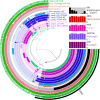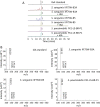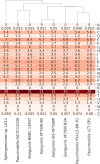Genomic Characterization of Potential Plant Growth-Promoting Features of Sphingomonas Strains Isolated from the International Space Station
- PMID: 35019675
- PMCID: PMC8754149
- DOI: 10.1128/spectrum.01994-21
Genomic Characterization of Potential Plant Growth-Promoting Features of Sphingomonas Strains Isolated from the International Space Station
Abstract
In an ongoing microbial tracking investigation of the International Space Station (ISS), several Sphingomonas strains were isolated. Based on the 16S rRNA gene sequence, phylogenetic analysis identified the ISS strains as Sphingomonas sanguinis (n = 2) and one strain isolated from the Kennedy Space Center cleanroom (used to assemble various Mars mission spacecraft components) as Sphingomonas paucimobilis. Metagenomic sequence analyses of different ISS locations identified 23 Sphingomonas species. An abundance of shotgun metagenomic reads were detected for S. sanguinis in the location from where the ISS strains were isolated. A complete metagenome-assembled genome was generated from the shotgun reads metagenome, and its comparison with the whole-genome sequences (WGS) of the ISS S. sanguinis isolates revealed that they were highly similar. In addition to the phylogeny, the WGS of these Sphingomonas strains were compared with the WGS of the type strains to elucidate genes that can potentially aid in plant growth promotion. Furthermore, the WGS comparison of these strains with the well-characterized Sphingomonas sp. LK11, an arid desert strain, identified several genes responsible for the production of phytohormones and for stress tolerance. Production of one of the phytohormones, indole-3-acetic acid, was further confirmed in the ISS strains using liquid chromatography-mass spectrometry. Pathways associated with phosphate uptake, metabolism, and solubilization in soil were conserved across all the S. sanguinis and S. paucimobilis strains tested. Furthermore, genes thought to promote plant resistance to abiotic stress, including heat/cold shock response, heavy metal resistance, and oxidative and osmotic stress resistance, appear to be present in these space-related S. sanguinis and S. paucimobilis strains. Characterizing these biotechnologically important microorganisms found on the ISS and harnessing their key features will aid in the development of self-sustainable long-term space missions in the future. IMPORTANCESphingomonas is ubiquitous in nature, including the anthropogenically contaminated extreme environments. Members of the Sphingomonas genus have been identified as potential candidates for space biomining beyond earth. This study describes the isolation and identification of Sphingomonas members from the ISS, which are capable of producing the phytohormone indole-3-acetic acid. Microbial production of phytohormones will help future in situ studies, grow plants beyond low earth orbit, and establish self-sustainable life support systems. Beyond phytohormone production, stable genomic elements of abiotic stress resistance, heavy metal resistance, and oxidative and osmotic stress resistance were identified, rendering the ISS Sphingomonas isolate a strong candidate for biotechnology-related applications.
Keywords: International Space Station; Sphingomonas; phytohormones; plant growth promotion.
Conflict of interest statement
The authors declare no conflict of interest.
Reference herein to any specific commercial product, process, or service by trade name, trademark, manufacturer, or otherwise does not constitute or imply its endorsement by the U.S. Government or the Jet Propulsion Laboratory, California Institute of Technology.
Figures







Similar articles
-
Phylogenomics, phenotypic, and functional traits of five novel (Earth-derived) bacterial species isolated from the International Space Station and their prevalence in metagenomes.Sci Rep. 2023 Nov 6;13(1):19207. doi: 10.1038/s41598-023-44172-w. Sci Rep. 2023. PMID: 37932283 Free PMC article.
-
Whole metagenome profiles of particulates collected from the International Space Station.Microbiome. 2017 Jul 17;5(1):81. doi: 10.1186/s40168-017-0292-4. Microbiome. 2017. PMID: 28716113 Free PMC article.
-
Comprehensive Genome Analysis on the Novel Species Sphingomonas panacis DCY99T Reveals Insights into Iron Tolerance of Ginseng.Int J Mol Sci. 2020 Mar 16;21(6):2019. doi: 10.3390/ijms21062019. Int J Mol Sci. 2020. PMID: 32188055 Free PMC article.
-
Sphingomonas: from diversity and genomics to functional role in environmental remediation and plant growth.Crit Rev Biotechnol. 2020 Mar;40(2):138-152. doi: 10.1080/07388551.2019.1709793. Epub 2020 Jan 6. Crit Rev Biotechnol. 2020. PMID: 31906737 Review.
-
Potential biofilm control strategies for extended spaceflight missions.Biofilm. 2020 May 30;2:100026. doi: 10.1016/j.bioflm.2020.100026. eCollection 2020 Dec. Biofilm. 2020. PMID: 33447811 Free PMC article. Review.
Cited by
-
Effects of maturity stage and mancozeb on phyllosphere microbial communities and the plant health potential of silage maize.Front Plant Sci. 2025 Jun 4;16:1581401. doi: 10.3389/fpls.2025.1581401. eCollection 2025. Front Plant Sci. 2025. PMID: 40535930 Free PMC article.
-
Space-driven ROS in cells: a hidden danger to astronaut health and food safety.NPJ Microgravity. 2025 Aug 4;11(1):52. doi: 10.1038/s41526-025-00492-x. NPJ Microgravity. 2025. PMID: 40759890 Free PMC article. Review.
-
Positive impact of hydroponics and artificial light on yield and quality of wheat.Sci Rep. 2025 Aug 21;15(1):30768. doi: 10.1038/s41598-025-16204-0. Sci Rep. 2025. PMID: 40841578 Free PMC article.
-
Vaginal microbiota in term pregnant women with differences in cervical ripeness revealed by 2bRAD-M.BMC Microbiol. 2024 Nov 1;24(1):444. doi: 10.1186/s12866-024-03612-x. BMC Microbiol. 2024. PMID: 39487440 Free PMC article.
-
Biogeographical Distribution of Bacteria in Soils with Identical Agricultural Practices: Impacts of Environmental Factors.Curr Microbiol. 2025 Aug 3;82(9):430. doi: 10.1007/s00284-025-04404-w. Curr Microbiol. 2025. PMID: 40754597 Free PMC article.
References
-
- Balkwill DL, Fredrickson JK, Romine MF. 2006. Sphingomonas and related genera, p 605–629. In Dworkin M, Falkow S, Rosenberg E, Schleifer K-H, Stackebrandt E (ed), The prokaryotes: volume 7: proteobacteria: delta, epsilon subclass. Springer New York, New York, NY. doi:10.1007/0-387-30747-8_23. - DOI
Publication types
MeSH terms
Substances
Supplementary concepts
LinkOut - more resources
Full Text Sources
Molecular Biology Databases
Miscellaneous

